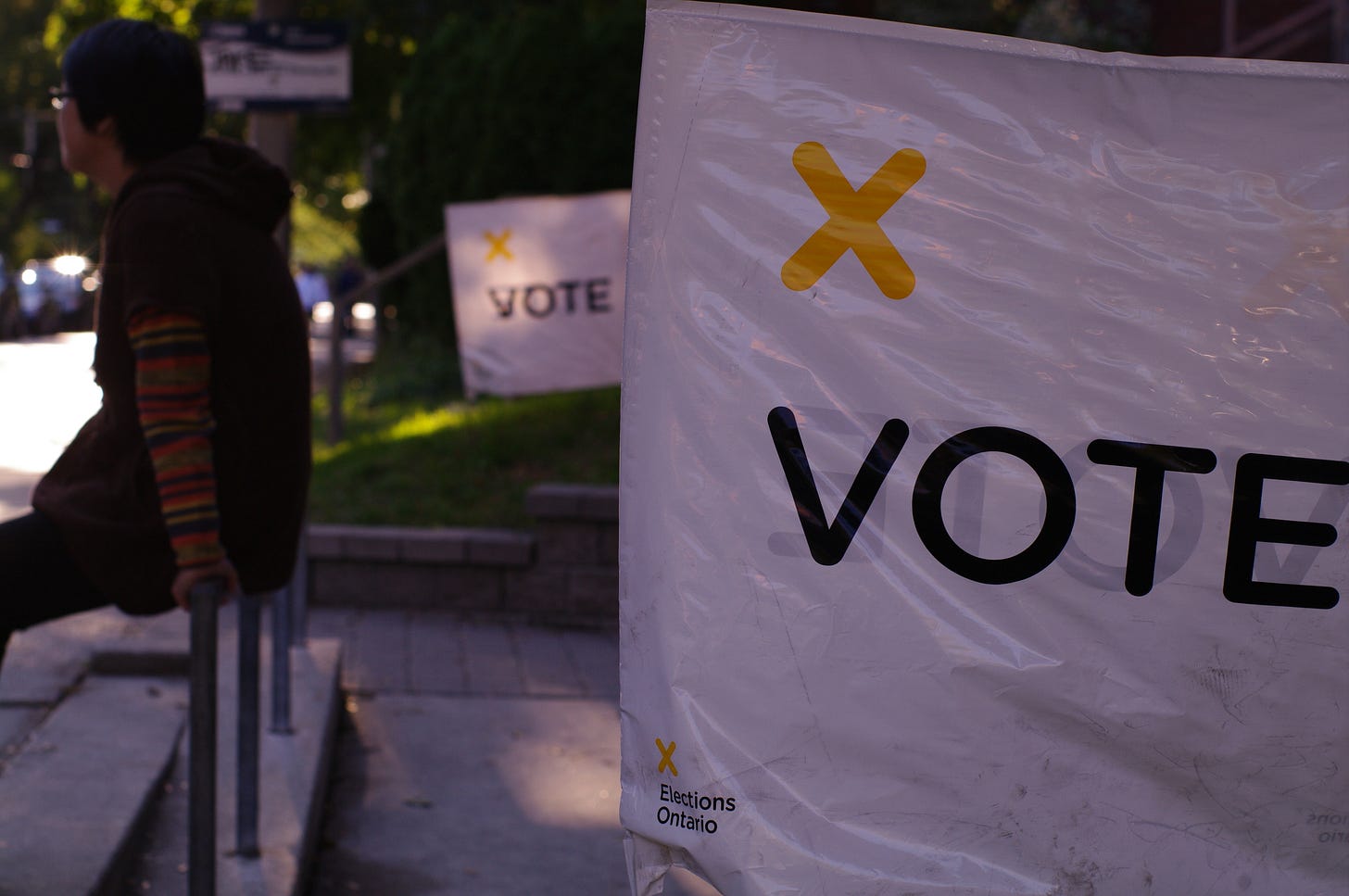Ontario's per-vote subsidy means you need to vote your conscience.
It's not "strategic" voting if the strategy is flawed.

Every time a Federal or Provincial election happens in Ontario, there’s always a bunch of huffing and puffing about “strategic voting” and “wasting your vote” and “compromising to win”.
But there’s probably something you didn’t know: Elections Ontario gives each central party and riding association a per-vote subsidy, based on how many votes they received in the last general election.
Political parties will receive $0.636 CAD in each quarter of 2025 for each vote they received in the 2022 Ontario Provincial Election. At the local level, riding associations will receive a proportionate share of the quarterly fund allotted to that riding, which was $4,879.17 CAD in 2024.
The requirements for a political party or a riding association to receive funding are very simple:
A registered party must receive either 2% of the popular vote province-wide, or 5% of the popular vote across the ridings in which they nominated a candidate
A riding association’s candidate must receive 2% of the votes in that riding, and that riding association must maintain and file complete financial records for the past four years in order to continue receiving quarterly benefits
This changes things, considerably. While you may be voting for a candidate that won’t win, you’ll be providing that candidate and their party an ongoing financial subsidy based on your vote, which will fund their political activities going forward.
For political parties, it also provides a benefit to those with an inefficient vote. Your party’s share of the popular vote may be too diffused to win many seats, but your overall popularity across the whole province will benefit you.
In short, a per-vote subsidy means that politicians rely less on big money donors, and more on popularity with their real boss, the voting public.
Obviously, fundraising is still necessary, especially for a new party or minor party which has never cleared the bar in a previous election. But this is a much lower obstacle than you would expect.
After the 2022 Ontario Provincial Election, two minor right-wing parties gained sufficient vote share across the province to qualify. In 2025, the New Blue Party will receive ~$81k CAD per quarter, while the Ontario Party will receive ~$53k CAD per quarter.
Mind you, this is miniscule compared to what the four major parties will receive, but it is consistent funding that allows these minor parties to hire staff and run proper campaigns to try and win larger vote shares in the next election.
The benefits are much more clear when we do get to those big four parties. The Greens are the lowest at ~$178k CAD per quarter, while the NDP and Liberals are effectively tied at ~$710k CAD and ~$715k CAD per quarter.
Finally, the Tories rake in the big money at ~$1.221 million CAD per quarter. Obviously, all of these parties benefit from this consistent quarterly funding, and would be even further reliant upon wealthy donors without this per-vote subsidy.
But Conservatives do not resent their reliance upon big money; it is a willing and collaborative relationship. That is why Bill 220, passed by the Ford Government in November 2024, will end the per-vote subsidy on December 31st, 2026.
Obviously, I think that would be a terrible thing for democracy. Doug Ford already doubled the political donation limit in Ontario, which is now a massive $3,400 CAD per year while next door in Québec it is only $100 CAD.
If anything we should be doubling the per-vote subsidy, and slashing the donation limit instead. Québec has a healthy and competitive multipartisan democracy with a per-vote subsidy of their own, and a much smaller donation limit, meaning that politicians have to be more responsive to the population they represent.
But right now, the system in Ontario is what it is, and that means your choice on February 27th has a new element to consider before you cast a ballot. My advice?
Ignore strategic voting. Fuck strategic voting. Both the Liberals and the NDP will tell you they’re the “strategic” vote while refusing to change the FPTP system that forces these decisions.
It is a rank degeneracy in our democracy, a race to the bottom where people are forced to vote for the candidate they hate the least rather than the person they actually like.
The per-vote subsidy is a breath of fresh air, an encouragement to vote for your ideals and your principles even if it won’t give you an immediate reward.
I want a democracy where people vote based on their conscience, rather than their fears. I’m glad that the per-vote subsidy will provide roughly two years of funding under the current law.
You should vote for a candidate who will keep and expand the per-vote subsidy. You should vote honestly, for someone who represents your true beliefs.
Because when you stop voting “strategically”, when you begin voting truthfully, our democracy may finally begin to heal from the damage.




I get all your points about the subsidy and I 100% agree with your stance on voting strategically. However as someone who doesn’t feel represented by the large parties I have a lot of problems with the subsidy. It feels like it gives the parties that already have an advantage more of an advantage like giving the best team in the league a first round draft pick. How about instead of relying more on large donors, these parties have to rely more on getting out and talking to people, holding town halls and debates rather then ads and busses with their faces on them? I’m not suggesting scrapping the subsidy but rather subsidize parties and candidates that don’t already have a massive infrastructure in place and let the parties that are able to raise huge amounts of cash fend for themselves.